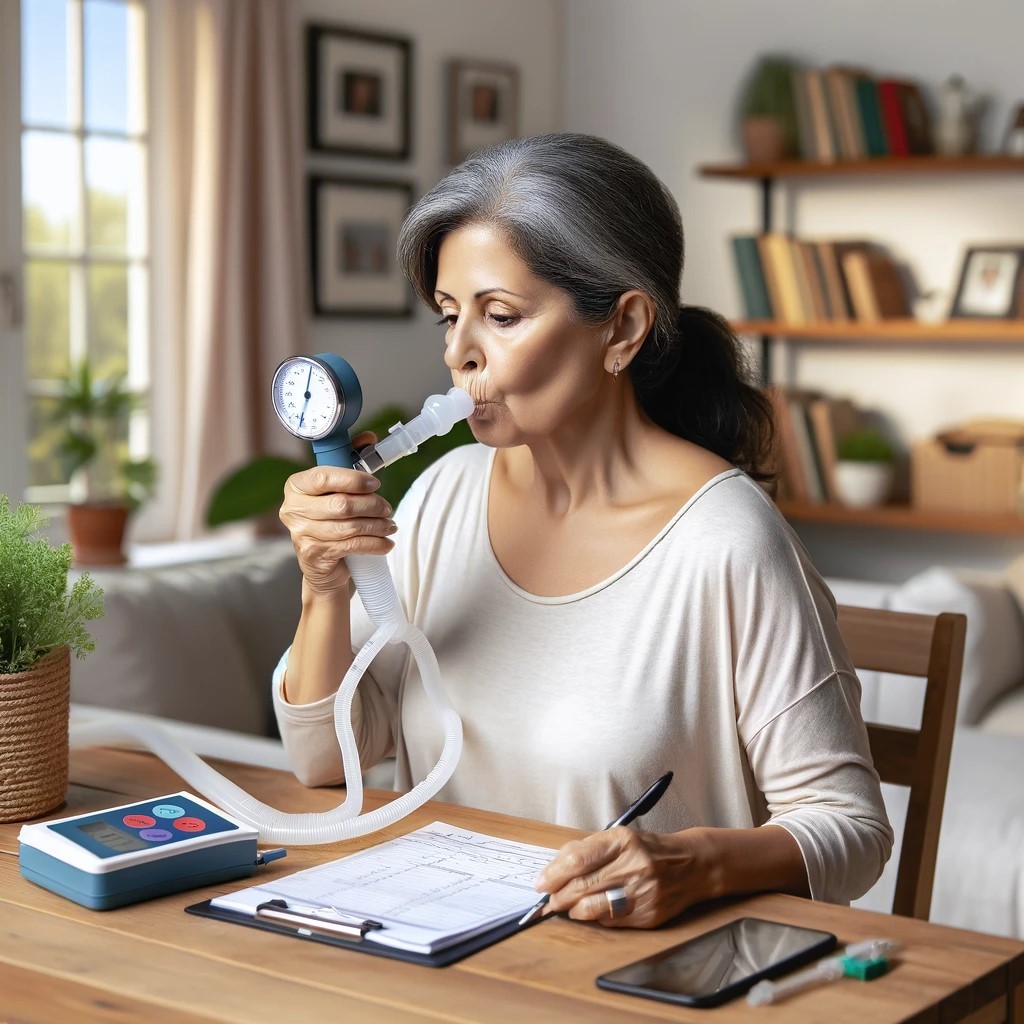How to Test Lung Capacity at Home: Proven Techniques.
Discover effective ways how to test lung capacity at home with proven techniques. Take charge of your respiratory health today!
Introduction to How to Test Lung Capacity at Home

Every breath is a symphony of intricate bodily functions working in harmony. At the heart of this process is our lung capacity – a crucial measure of respiratory health. For those who wish to keep a vigilant eye on their breathing prowess, understanding how to test lung capacity at home is a valuable skill. In this blog, we delve into the practical steps you can take to monitor this vital health indicator within the comfort of your own home. So, at the end of this blog post, you will learn How to Test Lung Capacity at Home. I did this test, and I am happy with these diagnosis tools.
Understanding Lung Capacity

What Exactly is Lung Capacity?
At its core, lung capacity represents the volume of air that our lungs can hold. It’s an umbrella term that encompasses various measures. Think of tidal volume as the air you breathe in and out normally and total lung capacity as the total amount of air your lungs can hold at their max. Inhalation.
The Significance of Lung Capacity
Awareness of your lung capacity is more than just a set of numbers; it’s a window into your overall well-being. For individuals managing respiratory conditions, athletes, or anyone focused on health optimization, having this data can be transformational.
Factors That Influence Lung Capacity
Age: Youth brings peak lung function, which gradually wanes with time.
Fitness Level: Aerobic fitness can significantly boost lung efficiency.
Altitude: At lofty heights, the air’s embrace is lighter, influencing how much oxygen you can take in.
Exposure to Harmful Substances: Smoking and pollution are archenemies of lung elasticity and capacity.
The Science Behind Measuring Lung Capacity
The Nitty-Gritty of Lung Volumes
Lung volumes such as tidal volume, vital capacity, and total lung capacity provide a detailed landscape of our respiratory capabilities. Understanding these terms lays the groundwork for accurately assessing lung function at home.
Comparing Clinical and At-Home Assessments
How to Test Lung Capacity at Home?
While nothing can replace the precision of clinical spirometry, home testing offers a convenient and regular means of keeping tabs on your lung health. It is not meant to diagnose but to act as a barometer for when professional consultation might be necessary.
Preparing to Test Lung Capacity at Home

Preparing to Test Lung Capacity at Home
Ensuring a Safe Testing Environment
It’s imperative to conduct these tests in a safe environment. If you have a pre-existing condition or are in respiratory distress, consult with a healthcare provider beforehand. Choose a tranquil space with clean air to avoid skewing the results.
Timing and Consistency
Performing the test concurrently day, in the morning, can help maintain consistency in your readings.
DIY Techniques to Estimate for How to Test Lung Capacity at Home

The “Balloon Blow” Technique
This method involves taking a deep breath and inflating a balloon to its fullest with one exhale. The diameter of the balloon can give you an indirect measure of your lung capacity.
The “Straw and Water” Method
Blowing through a straw into a container with water can displace a certain volume, which can be measured to give a rudimentary estimate of your lung capacity.
Digital Spirometry
Various apps have been designed to approximate lung capacity using your phone’s microphone. While convenient, these should be used with an understanding of their limitations and never as a substitute for professional medical assessment.
Tools and Equipment to Aid in Testing Lung Capacity
Here are the best tools for How to Test Lung Capacity at Home:
Crafting a Homemade Spirometer
With a few household items, you can create a simple device to visualize your breath’s force and volume, providing a tangible measure of your lung capacity.
Over-the-Counter Spirometry Devices
There are affordable spirometers available for home use that can offer insights into your lung health. Though not as precise as their clinical counterparts, they can be useful for regular monitoring.
Interpreting Your Results of How to Test Lung Capacity at Home
Deciphering the Numbers
It’s not just about how big the numbers are but what they mean in age, gender, and health norms. It’s crucial to approach the interpretation of home test results with caution and awareness of their estimated nature.
Limitations of At-Home Testing
Home tests are not diagnostic tools. They should be seen as part of a broader approach to health monitoring and not standalone verdicts on your respiratory health.
Enhancing Lung Capacity
Exercises for Bigger Breaths
Incorporate exercises like deep breathing techniques and regular aerobic activities into your routine to help expand lung capacity and strengthen respiratory muscles.
Lifestyle Adjustments for Optimal Lung Function
Quit smoking, minimize exposure to pollutants, and maintain a diet rich in antioxidants to give your lungs the best fighting chance for health.
Tracking Your Lung Capacity Over Time
The Power of a Consistent Record
Keeping a diary of your lung capacity readings can be an invaluable tool in recognizing trends and taking timely action should a decline in lung function become apparent.
Frequently Asked Questions (FAQs) about How to Test Lung Capacity at Home
This section will aim to tackle the most common inquiries about How to Test Lung Capacity at Home, offering clarity and peace of mind to those new to the concept.
How can I test my lung capacity myself?
To test your lung capacity at home, you can use several simple methods. One popular DIY method is the ‘Balloon Blow’ technique, where you fully inflate a balloon with a single breath. Measure the diameter of the balloon to get an estimate of your lung volume. Consistency is key, so make sure to do the test under similar conditions each time.
How can I check my lung capacity at home without equipment?
Without any equipment, you can perform a basic version of a spirometry test. Inhale deeply, then blow out as strong and fast as possible, keeping track of how long you can maintain the forceful exhale. While this won’t give you a precise measurement, it does offer a rudimentary insight into your lung capacity.
How do you check if my lungs are OK?
Checking if your lungs are healthy involves a combination of self-monitoring and professional evaluation. At home, you can monitor for signs like consistent coughing; if you experience wheezing, breathlessness, or chest pain while breathing, it’s advisable to see a healthcare professional. They can perform tests like spirometry or a chest X-ray for a precise evaluation.
How do I know if my lung capacity is low?
Signs of reduced lung capacity may manifest as breathing challenges during everyday tasks, inability to take a deep breath, feeling of tightness in the chest, or rapid breathing. If you’re using at-home testing methods and notice a decrease in your readings over time, this may also indicate a reduced lung capacity.
How can I improve my lungs?
Improving lung health can be achieved through regular exercise, especially cardiovascular activities that require deep breathing, like swimming or running. Try out different breathing techniques, like diaphragmatic breathing or pursed-lip breathing, which are also beneficial. Additionally, avoiding smoking and reducing exposure to pollutants can significantly improve lung function.
Is holding your breath for 2 minutes good?
Holding your breath for 2 minutes is usually seen as an indicator of good breath control and lung capacity, often associated with practice from activities such as swimming or meditation. However, it should be done cautiously and incrementally to avoid stressing the body.
How long can a healthy person hold their breath?
A healthy individual typically can hold their breath for about 30 seconds to 2 minutes. However, with practice, like in the case of free divers, this duration can be significantly longer. Always ensure safety and never attempt to hold your breath to the point of discomfort or pain.
What’s the average duration a regular person can hold their breath?
Typically, people can go without breathing for about one to two minutes on average. It’s important to note that holding your breath for prolonged periods without proper training and safety measures can be dangerous.
How many seconds a normal person can hold their breath?
For most people, holding their breath for 30 to 60 seconds is achievable. This time can vary based on health, fitness level, and breath-holding practice.
What happens if you hold your breath for an extended period?
Holding your breath for too long can lead to a build-up of carbon dioxide in the blood, which can result in discomfort, dizziness, and, in extreme cases, loss of consciousness. It’s essential not to push beyond one’s comfort limit.
What are some breathing exercises?
Some beneficial breathing exercises include:
Diaphragmatic breathing: Focus on breathing deeply into the belly rather than the chest.
Pursed-lip breathing: Breathe in through the nose and out through pursed lips as if blowing out a candle.
Rib stretch: Stand upright, breathe deeply until you can’t inhale anymore, hold for 20 seconds, then exhale slowly.
Numbered breath: Inhale while counting to four, hold for four, and exhale for four.
By incorporating these practices regularly, you can help maintain and even improve your lung health. Remember, for any concerns regarding your lung capacity or fitness, consult with a healthcare professional.
Conclusion about How to Test Lung Capacity at Home
Consistent at-home monitoring of lung capacity isn’t just about numbers; it’s a proactive step toward maintaining respiratory health and ensuring a better quality of life. With the techniques and insights shared here, you can confidently assess and track your lung health.
Finally
As we conclude, we encourage you to engage with the content, share your experiences, and help foster a community dedicated to improving and maintaining lung health. Let’s breathe easier together.



